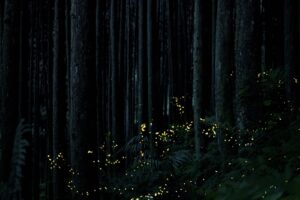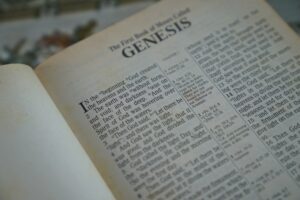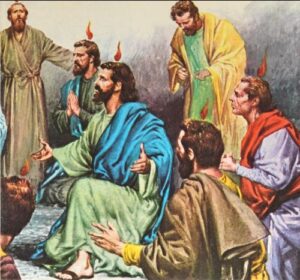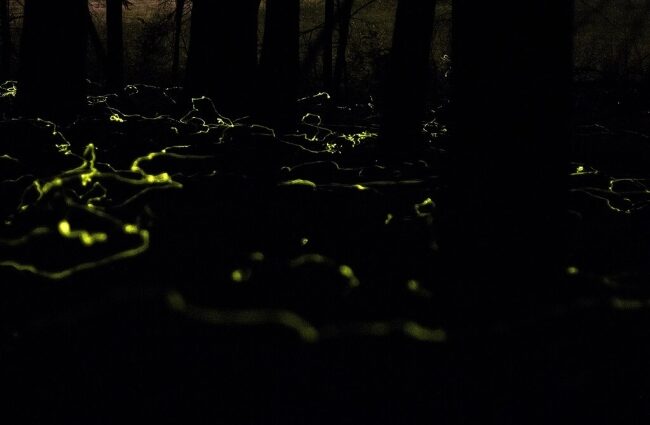You never know what you will find walking in the dark. I found this to be even more true when walking in twilight.
We were on a mission. We were looking for a small and luminous firefly, the Blue Ghost. We all know the more common, synchronous, firefly that blinks a yellow-white staccato signal. As kids we ran around our yard catching them in mason jars, to watch them turn on and off like miniature traffic lights. The white-yellows of the common fast-flashers. The white-yellow light of the fast-flashers were brief encounters that illuminates an instant, like a bio-luminous haiku.

But Blue Ghosts are not that kind of poem. The verse of the Blue Ghost, however, is a long, slow sigh, more like an elegy or a prose poem lingering over each word and phrase. Its pale blue light stretches, hovers, almost kissing the Lady ferns, leaves, mosses, damp logs, and tall grasses.
Their courtship dance differs from that of their more common cousins. Rather than flash their amorous messages in the Morse Code of sharp dots and dashes, their love light seems to hang glide over the forest floor like long, languishing caresses.
This, my wife and I had to see and were in a perfect place to see it. While the Blue Ghost is seen in a variety of locations in the central and eastern United States, they are most often spotted in the southern Appalachian Mountains. That’s us. We live in Transylvania County, North Carolina. The county name, “between forests,” is apt because we live on the border of both the Pisgah National Forest and the DuPont State Forest. Each of these areas is prime viewing for the Blue Ghosts.
As we had to be in the perfect place, we also had to wait for the perfect time to view them, which is just before sunset and the onset of darkness. We walked the Fawn Lake Trail a quarter mile from its Dupont State Forest parking lot. From there, we would have a half-mile walk up a slow grade to the lake. We did not have to walk far; just a few hundred feet would do. But we needed to be out of reach of the parking lot lights, cars, and occasional flashlights of twilight strollers. We found a prime spot to watch and to wait.
We had a narrow window in which to see them. Sightings occur for only two weeks in the summer, peaking around the first of June. Not only that, but the best viewing time was just around dusk and so we were on the trail by 9 p.m.
Twilight seems to arrive differently in the forest. The darkening does not happen right away. It takes its time. Night snuggled down deep into the fallen leaves, the hollows of logs and Christmas ferns. I looked behind me to see a stretch of gravel erased by the dark, step-by-step. Light seemed to seep away like grains of sand running through our fingers.
Then, when I least expected it, my first Blue Ghost floated just above the forest floor. It flew less like a pilot and more like a pale blue pilgrim. It hovered, searching for signals from possible mating partners. Soon, more appeared, and their steady light stretched out their flight lines like elegant 18th century signatures.

Yet, for all the elaborate light it spread, the pale blue spectacle emphasized the twilight; it did not diminish it. It did not brighten the night so much as illuminate the deepening twilight.
I searched for the right word to capture both a growing darkness and the firefly’s lingering illumination. That word is “gloaming.” It is an old-fashioned word, with its usage peaking between 1870 and 1890. But it still retains all the vigor and all the haunting qualities that still evoke ambiguity, awe, and allure. According to the Oxford English Dictionary, gloaming comes from the Old English glóm, meaning “twilight.” The root comes from the Germanic glô, that certain light, a “glow,” in the sky during dusk and dawn—that last gasp of daylight.
The Germanic glô illustrates the exquisite paradox of gloaming’s mixture of glow and gloom. Most forest-inclined people have seen this light near sunset. The near-night sky smolders in some places and plays tag with shadows in others.
The leaves and branches obscured the sky, but also created art out of the twilight. The interplay of glow and gloom is like the stained-glass windows in Gothic cathedrals. The shadowy branches were like the metal stripping connecting pieces of stained-glass windows. The sky shone through revealing patterns of color in a grand, but gloaming chancel.
Even the Blue Ghost’s scientific name is synonymous with both glowing and gloaming. It is in the Lampyridae family, literally meaning in the family of the glowing marsh or moor. The Blue Ghost is inseparable from the dark and dismal places in which it shines. The glow and the darkness together create the gloam with all its moody and messy ambiguities.
Looking at the Blue Ghost now in almost complete darkness, the lyric of its Latin name paints a vivid picture. Their shining goes hand-in-hand with their shadow. The light loiters in the swampy places, listening, watching. Its light seemed to take on a life of its own. The Blue Ghost’s lingering, blue light shone in the very places which seem most alien, even hostile, to it.

The Blue Ghost reminded me of the Holy Ghost. The Blue Ghost’s hovering over the dark decay of the forest floor reenacted Genesis. A Hebrew-English Old Testament uses the term “hover” to describe the spirit gliding over the face of the formless and empty deep in Genesis. In Hebrew “hovering” is pronounced rachaph, which could mean “move softly, “cherish,” or to “brood” with the implication of impregnating something. Later in the Bible, an eagle is described as “brooding” over her chicks.
Likewise, the Holy Ghost illuminated and impregnated the world with meaning and order. The Holy Ghost brooded over the chaos to create time and space. Just so, the Blue Ghosts brooded over the forest floor to create the birth cycle over again. Both Ghosts fashioned their own versions of beauty into the world.
Moreover, the term for “spirit” in the Biblical Greek and Hebrew is the same for “breath” and “wind.” While we say that the Spirit hovered over the face of the deep, so we could also say the wind or breath hovered there. The wind or breath, too, hovers and broods across the forest floor and the face of the earth. While the Spirit can be invisible and other-worldly, we have an intimate acquaintance with breath and wind.
Maybe we cannot always see the Spirit, but we can often feel her. We sense those inhales and exhales if we are paying attention. They have weight and bulk. Wind has force and speed. Our clothes dance in the wind; leaves lift and swell to the breath of wind and spirit.
In the New Testament, John’s gospel says the spirit goes where it wants. Though we can hear it, but we do not know from where it comes or to where it goes. We can see its impact, too, like a ship plowing through the water, we can see the wake it makes.

In the Biblical Book of Acts, the wind or breath produced a light, like tongues of flame around the heads of the apostles. The breath brought prophesy and dreams. The Holy Ghost brought a light into their fearful hearts of darkness. The Blue Ghosts brought its own light into the heart of the gloaming forest. The Holy Ghost meant to transform fearful men and women into apostles of the God who became a man. Because the Spirit became flesh, all matter is joined with Spirit and all Spirit with matter. That includes the lowly and illuminating Blue Ghosts. They urge us to look for the light and offer us a model by which to appreciate the spirit.
For now, the wind whispered across my face and neck. It felt like someone’s breath stood right behind me. A breeze seemed to hover around me so close that it curled inside my own breath—a breath that I can no longer call my own. Here, I share my breath with all who have breath and all who have wings and wind. These I share, too, with Blue Ghost’s long, elegant streaks and their cousins the fast-flasher fireflies.
The long, lingering streaks were like the script of some melancholy Mystery. It was a Mystery because it hinted at something holy. It was melancholy because the light was wandering, an uncertain search for something that may never be found. However, the light in the gloaming was not a Mystery to be solved, but an ambiguity to be explored. It was not a Mystery to be ignored, but a wonder to be welcomed. Sometimes comparisons help unwrap such Mysteries. That Mystery is nothing imaginary, but touches us body and soul.
—end—
Ronald K. Bullis, Ph.D., M.Div. specializes in writing on religious pilgrimage and on sacred places. The search for Blue Ghost fireflies in Southern Appalachia was such an occasion. He has published prose and poetry in Busted Halo, Parabola, Studia Mystica, Dry Creek Review, Black Buzzard, Orange Willow Review, Parnassus, Midwest Poetry Review, and most recently, a photo-prose piece in As Surely as the Sun and poems in the Penwood Review (fall, 2024).
**Featured image credit: Blue Ghost Fireflies [Phausis reticulata] by Evan M. Raskin – Wikimedia via iNaturalist, no. 4088716, {{Cc-by-4.0}}
